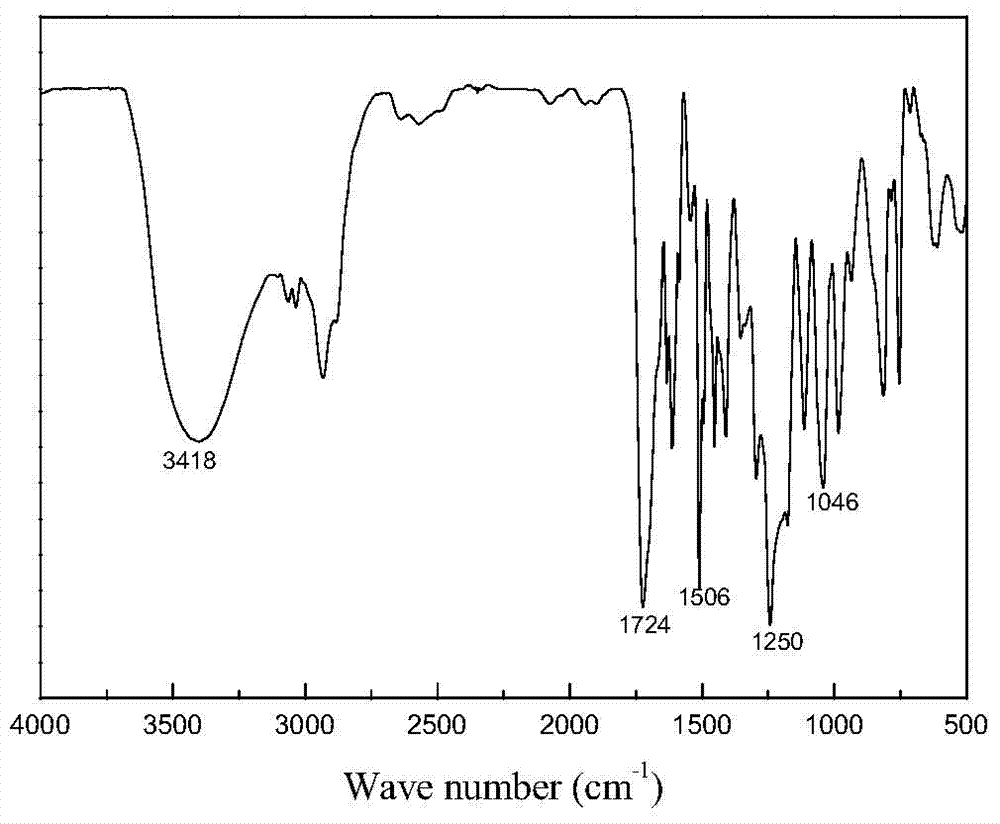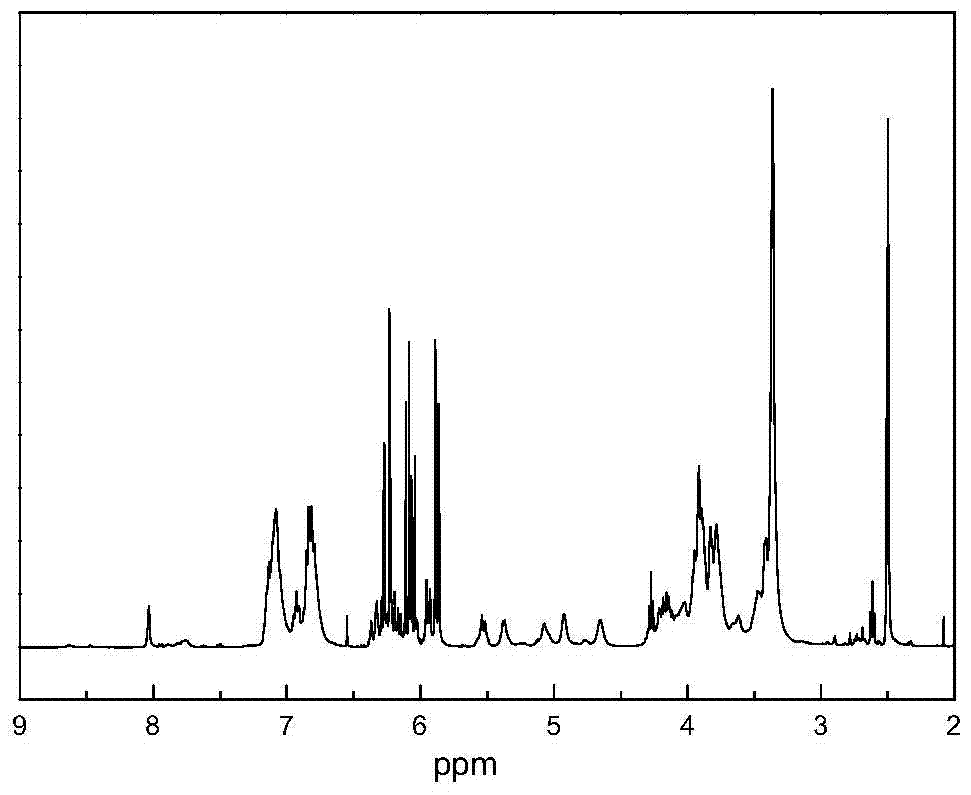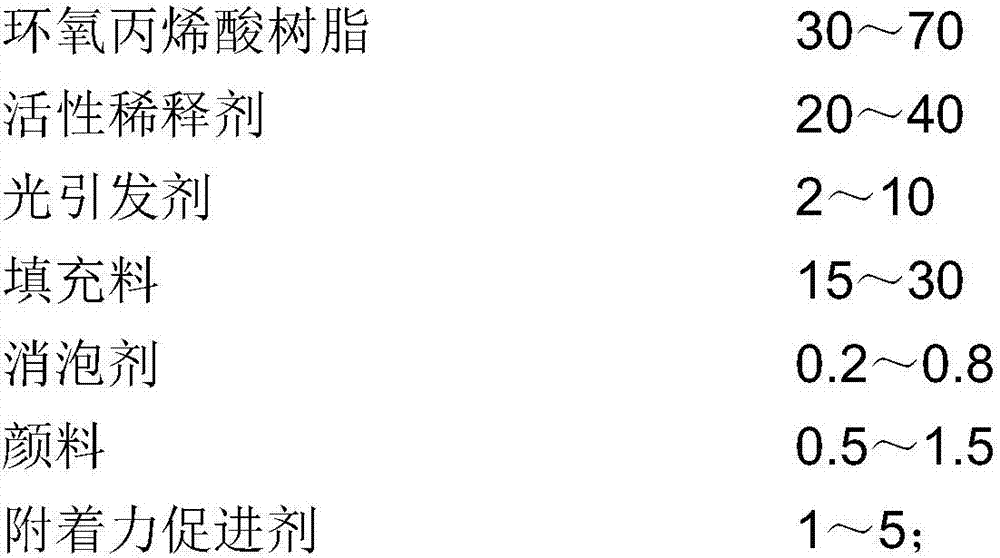A kind of dehydration type protective ink and preparation method thereof
A type-release and ink technology, applied in the chemical industry, can solve the problems of environmental pollution safety hazards, easily corroded glass, a large amount of waste alkaline water, etc., and achieve the effects of improving glass adhesion, easy filtration and separation, and improving flexibility
- Summary
- Abstract
- Description
- Claims
- Application Information
AI Technical Summary
Problems solved by technology
Method used
Image
Examples
Embodiment 1
[0030] 100 grams (0.44mol) of epoxy resin (E-44), 0.2 grams of triphenylphosphine, and 0.14 grams of hydroquinone were added to the reactor, and the temperature was raised to 100°C. (0.72mol) The mixed solution of AMPS was slowly and continuously added dropwise for 60 minutes with a constant pressure funnel, and after the dropwise addition was completed, it was incubated at 110° C. for 3 hours to obtain epoxy acrylic resin. figure 1 and figure 2 Infrared and NMR spectra of epoxy acrylic resin respectively, it can be seen from the figure that C=C, -NH 2 -C=O, -CH-O, -CH-SO 3 -, -CH 3 The presence of such characteristic peaks proves the successful synthesis of the target product.
[0031] Weigh the following raw materials in parts by weight: 50 parts of epoxy acrylic resin, 20 parts of lauryl methacrylate, 5 parts of 1-hydroxycyclohexyl phenyl ketone, 25 parts of talcum powder, 0.5 parts of defoamer, 1.0 parts of phthalocyanine blue Parts, 2.5 parts of methacryloyltrimethox...
Embodiment 2
[0033] 100 grams (0.44mol) of epoxy resin (E-44), 0.2 grams of triphenylphosphine, and 0.14 grams of hydroquinone were added to the reactor, and the temperature was raised to 100°C. (0.72mol) The mixed solution of AMPS was slowly and continuously added dropwise for 60 minutes with a constant pressure funnel, and after the dropwise addition was completed, it was incubated at 110° C. for 3 hours to obtain epoxy acrylic resin.
[0034] Weigh the following raw materials in parts by weight: 50 parts of epoxy acrylic resin, 25 parts of hydroxyethyl methacrylate, 5 parts of 1-hydroxycyclohexyl phenyl ketone, 25 parts of talcum powder, 0.5 parts of defoamer, phthalocyanine blue 1.0 parts, 2.5 parts of methacryloyltrimethoxysilane. Mix epoxy acrylic resin with active diluent, add photoinitiator, filler, pigment, defoamer, etc., and form a uniform viscous liquid after high-speed stirring, put the viscous liquid into a grinder and grind it to get protective ink finished product.
Embodiment 3
[0036] 100 grams (0.44mol) of epoxy resin (E-44), 0.2 grams of triphenylphosphine, and 0.14 grams of hydroquinone were added to the reactor, and the temperature was raised to 100°C. (0.72mol) The mixed solution of AMPS was slowly and continuously added dropwise for 60 minutes with a constant pressure funnel, and after the dropwise addition was completed, it was incubated at 110° C. for 3 hours to obtain epoxy acrylic resin.
[0037]Weigh the following raw materials in parts by weight: 50 parts of epoxy acrylic resin, 25 parts of hydroxyethyl methacrylate, 2-methyl-1-[4-(methylthio)phenyl]-2-morpholinyl-1 - 6 parts of acetone, 3 parts of isopropylthioxanthone, 25 parts of titanium dioxide, 0.5 parts of defoamer, 1.0 part of phthalocyanine blue, 2.5 parts of methacryloyltrimethoxysilane. Mix epoxy acrylic resin with active diluent, add photoinitiator, filler, pigment, defoamer, etc., and form a uniform viscous liquid after high-speed stirring, put the viscous liquid into a grind...
PUM
 Login to View More
Login to View More Abstract
Description
Claims
Application Information
 Login to View More
Login to View More - R&D
- Intellectual Property
- Life Sciences
- Materials
- Tech Scout
- Unparalleled Data Quality
- Higher Quality Content
- 60% Fewer Hallucinations
Browse by: Latest US Patents, China's latest patents, Technical Efficacy Thesaurus, Application Domain, Technology Topic, Popular Technical Reports.
© 2025 PatSnap. All rights reserved.Legal|Privacy policy|Modern Slavery Act Transparency Statement|Sitemap|About US| Contact US: help@patsnap.com



